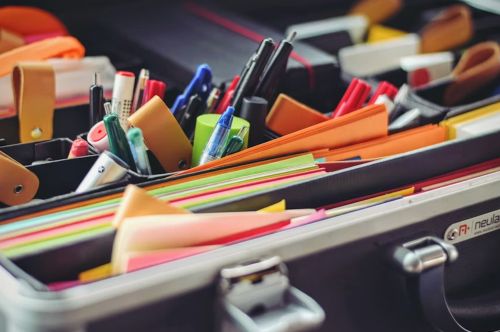

Ever wonder what the difference is between an organized classroom and a hot mess?
Storage. Case closed.
If you’re a teacher or work in a school, you know that the learning materials and supplies we have to manage can quickly get out of hand. Keeping everything easy for our students to access while minimizing distraction takes time and planning. With over 49.5 million students enrolled in public schools, we better have that organization down.
The problem is… a lot of schools still rely on the same old storage options that waste time and make classrooms cluttered. Plastic school tray storage systems have changed the game, though. These days, they help even the busiest, modern classrooms stay organized, accessible and tidy.
This article will show you how plastic tray storage can change your teaching game.
In this guide, we’ll cover:
- Why traditional storage options let teachers down
- The benefits of plastic tray storage explained
- What to look for when choosing a system for your needs
- Organization hacks that actually work
- Tips to make maintenance easy
Why Traditional Classroom Storage Sucks
Here’s something most educators know in their hearts already…
We’ve all used those big old wooden cubbies, or worse – just random bins and boxes. The problem with traditional storage is that it isn’t designed with visibility and accessibility in mind.
When teaching materials are buried in deep cabinets or stacked in unlabeled cardboard boxes, teachers lose instructional time digging. Kids can’t find what they need by themselves. And by Friday, everything is a disaster.
Storage should work for you, not against you.
Why Plastic Tray Storage Is Different
This is where plastic tray storage systems change the game.
Unlike old-school options, plastic tray storage is built with transparency and access in mind. Plastic trays stack vertically and each slides out independently so you have instant access without disturbing everything around it.
The benefits are obvious:
- Transparency – you can see what’s inside at a glance
- Individual access – student take materials without chaos
- Stackable design – maximizes vertical storage
- Durability – better withstands wear and tear than cardboard
- Easy to clean – wipe down in seconds
Here’s the thing… did you know…
The school furniture market alone is expected to be worth $8.6 billion by 2033. That includes storage solutions! (Storage is a big subcategory). Schools are starting to realize that proper storage and organization directly impacts student learning.
Choosing The Right Plastic Tray System For Your Classroom
Wait, there are different kinds of tray storage systems?
Yeah, they’re not all created equal.
Make sure to consider your specific needs before investing in a storage system. What you look for depends on…
Size and Capacity
This first is a function of what you’re storing. Art supplies? Student work? Books?
Shallow trays are fine for paper, worksheets and laminated materials. You’ll need deeper trays to hold bulkier items like scissors, glue and tape. The deepest trays are ideal for books, tablets or even larger student projects.
Frame Configuration
Tray systems are available in a variety of sizes and depths, from small 6-tray units to massive 30+ trays. The number of trays you need depends on your space and needs.
Small tray storage towers are great for tight spaces since they only take up floor space by their footprint. You can line a whole wall with vertical towers without eating into the room’s play area. For rooms with more space, horizontal tray units allow for even easier access for younger kids.
Tray Colors
Color-coding is key to a successful tray storage system. You can assign different colors to subjects, student groups or even material types. Suddenly everyone knows exactly where each type of material goes.
It eliminates those “Where does this go?” questions.
Smart Organization Strategies That Actually Work
Ok, now let’s talk about how to make plastic tray storage work for you.
Student-Centered Organization
Give every student their own tray for their personal supplies and work. This will eliminate the free for all we see with communal supplies and make students responsible for their own materials. They always know where their stuff is.
Subject-Based Systems
Assign specific trays for each subject. Blue trays could be for math manipulatives. Green for reading materials. Red for art supplies.
When it’s time to transition, students grab the subject tray you need and you’re ready to go in seconds.
Center-Based Storage
If you have learning centers, plastic tray storage is ideal. Each center gets its own tray with everything stored inside. Students rotate through centers grabbing and returning trays as they go.
Supply Distribution
Use trays as distribution stations for communal supplies like pencils, scissors and glue. Instead of one child at a time getting their own, many students can access these shared materials at once.
It’s pretty genius if you ask me.
Going Vertical With Plastic Tray Storage
Ok, here’s one of my favorite tricks…
Want to double your storage in the same space?
Go vertical. In most classrooms, we have tons of empty wall space. It’s a goldmine for tray storage units. Stacking trays vertically instead of piling on the floor multiplies your capacity without sacrificing floor space.
Wall-mounted systems also keep materials visible and accessible while freeing up workspace. And they create clear sight lines. Which is a major win for supervision.
Mobile tray units on casters are also great. Roll them where you need them, then tuck them away when you need more floor space.
Maintaining An Organized Tray Storage System
Let’s face it… The best storage system in the world won’t help you if you let it get out of hand.
The key is maintenance:
Label Everything
Clear labels mean no questions. Use pictures and symbols for younger students who can’t read yet.
Audit Schedule
Set aside 10 minutes once a week to do a quick audit. Make sure trays are stocked and ready to go. This little bit of effort will save you major headaches down the road.
Student Responsibility
Designate “storage managers” who check that materials are returned correctly each day. Rotating responsibility also teaches students organization while maintaining your system.
Cleaning Schedule
Plastic trays can collect dust, so be sure to wipe them down occasionally. Just a few seconds during transition time will keep them fresh.
Sticking To A Budget For Storage Solutions
Budget talk? I hate it. But it’s real.
Quality plastic tray storage is an investment that will save you time. Here are some tips to make it work.
Start with one or two units in areas with the most traffic. Demonstrate the benefit and watch teachers start asking for more. Many schools build out their storage infrastructure over several years.
Look for modular systems you can add onto later. Expand with more frames and trays as budgets allow without needing to replace the whole thing.
Wrap-Up: The Bottom Line On Classroom Storage
Plastic tray storage systems make learning environments where teachers can teach and students can focus.
When every material has a specific, accessible home that every student can reach on their own, our classrooms run smoothly.
Every minute we spend looking for supplies is instructional time we’re stealing. Every distraction created by disorganization yanks our students’ focus away from learning. Quality storage systems eliminates both problems.
Schools who prioritize organization and functionality see measurable results. Students develop greater independence and responsibility. Teachers reduce stress and maximize instruction. The whole school is calmer, more productive.
So What’s The Next Step In Your Storage Strategy?
Ok, one more thing before you go…
It’s this:
It takes time and effort to create an organized classroom. Start by identifying your most pain point storage challenges – what things create the most chaos in your classroom? What areas do you lose the most time searching? Plastic tray storage fixes those problems.
Build your system in pieces, trying new strategies and refining as you see what works. The goal isn’t perfection – it’s progress towards a more functional learning environment.
And remember – the best storage system is the one that actually gets used. Choose solutions that fit your teaching style, your classroom’s space and meet your students’ needs. Your future, organized self will thank you.


